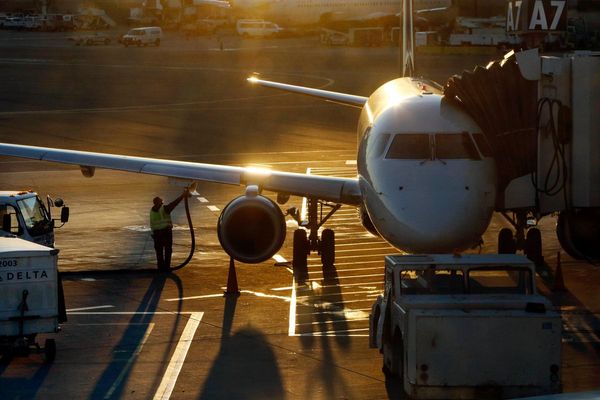
Aviation is an abundant source of metaphors, but not always as self-generating as the terrifying Alaska Airlines incident that has once again brought Boeing low: a hole blown in the side of an ascending plane, a gap that was not properly plugged, passengers staring into the void.
The safe landing of flight 1282 on 5 January after a boy literally lost the shirt from his back as the air was sucked out at 14,000 feet, means Boeing can count itself lucky that it does not face far worse than the Federal Aviation Administration investigation and a further audit announced this week and a handful of lawsuits from distressed passengers.
Only one variant of Boeing’s 737 Max model, the Max 9 with a sealed mid-rear exit door, has been grounded, pending inspections. The FAA will now try to determine whether Boeing failed to ensure its planes met the designs and were “in a condition for safe operation”. The National Transportation Safety Board’s accident investigators will be examining the missing chunk of fuselage found in an Oregon teacher’s back yard. And airlines and investors will be wondering more broadly, just who is failing to tighten the bolts at Boeing?
In an industry where every chief executive likes to intone that safety is the No 1 priority, Boeing has had to redouble efforts since the 737 Max disasters of 2018-19. Two crashes that killed 346 people led to the model being grounded worldwide for about 20 months and the exposure of internal company communications that suggested concerns were being suppressed in the race to fend off rival Airbus and produce a cheaper, more fuel-efficient single-aisle plane.
Since then, the last company to want to be seen skirting near the edge on safety would be Boeing – and the chief executive Dave Calhoun’s, acceptance of responsibility for the “quality escape” over the door plug blowout was broadly welcomed, even if there was little chance of blaming anyone else this time.
So what has gone wrong? Or rather – what has not been fixed? Boeing and regulators will be looking for the immediate defect at the company’s production and assembly plant in Seattle, Washington, and that of a leading supplier, Spirit AeroSystems, in Wichita, Kansas.
While the 737 Max 8 is Boeing’s top selling plane, the Max 9 is rare outside the US, with Alaska and United owning 144 of the 215 made. The US carriers operate the now grounded Max 9 variant with the mid-rear cabin door sealed, but airlines that have installed the maximum number of seats and are therefore required to have the door in operation under safety rules, can continue to fly.
Boeing will hope that any defect discovered has no bearing on other Max versions – or further reputational damage beyond. However, the manufacturer issued three warnings about 737 Max production defects in 2023, the latest just a week before the Alaska incident. If you find loose nuts in a rudder, and then in a door plug panel, at what point does it start to look like a systemic issue?
“The fact that there are loose bolts in young aircraft, not long off the production line, means they are going to have to look at processes and quality management as part of their investigation,” says John Strickland an aviation expert at JLS Consulting.
Regulators are in no hurry. “The safety of the flying public, not speed, will determine the timeline for returning the Boeing 737 Max 9 to service,” the FAA said.
On Friday, the agency went further, announcing an audit of the production line and suppliers, saying it believed there were “other manufacturing problems” at Boeing – a move that “suggests that the FAA has real safety concerns for the flying public”, says Carl Tobias, a law professor at the University of Richmond. “While the probe is ongoing, Boeing may continue to experience damage to its profitability and reputation, which it may have difficulty limiting.”

And Boeing, of course, has horrific previous. A congressional report blamed a “culture of concealment” for the fatal Max 737 crashes, which led to Boeing paying more than $2.5bn (£2bn) to settle legal claims in victim compensation and US fines as well as charges that it misled investors over concerns for the plane.
Strickland, part of a small group invited to tour Boeing HQ in Seattle when the Max was still grounded worldwide, says: “There’s no doubt from what we saw at the end of 2019 that they were making big steps to address processes and corporate culture.”
A flight safety centre aimed to expose all staff to their responsibility, “showing air crashes over the years as a reminder of the lives lost and the causes”, while representatives stressed a focus on transparency and enabling whistleblowing for any concerns.
Beyond the horrors of the crashes, Boeing has also struggled with faltering production rates. “There is a lot of commercial pressure to step up production to get planes out of the order book – which is not ever a justification for lesser quality or errors,” Strickland says. “But the pressure is there to get back to quality on time production, instead of late delivery.”
The pandemic may have played a part, he adds: “Across the industry, skilled staff were lost – and Boeing was no exception.”
A recurrent criticism has been that for too long Boeing prioritised dividends to investors over the job of designing and building planes. The elevation of Stephanie Pope to the new role of chief operating officer at the start of the year may not allay concerns about the hierarchy of engineering. Pope, widely seen as Calhoun’s most probable successor, has spent 30 years at the company but primarily on the financial side.
Since 2018, Boeing has not recorded an annual profit – and has fallen further behind Airbus in the pivotal short-haul single-aisle aircraft market. On Thursday, the European manufacturer announced it had delivered 735 commercial aircraft in 2023, an 11% increase on 2022, and taken 1,835 orders for its 737 equivalent, the A320 family of planes.
Boeing can take solace in that its rival has ridden out its own scandals, multibillion-dollar fines, and smaller product mishaps, such as cracks in A380 wings. For now, the US aerospace company’s share price has only fallen 10%, and the order book remains large.
Europe’s biggest carrier, Ryanair, opted to throw in its lot with Boeing and doubled down after the Max disasters, with a giant order at an undisclosed discount to reflect the plane’s tarnished status. The Irish airline’s chief executive, Michael O’Leary, has only railed at slow delivery of his promised Max 10s, and is relaxed on any consumer backlash: no customer, he said, had ever opted to take the refund or free switch that Ryanair offered for those who did not want to fly on a 737 Max.







